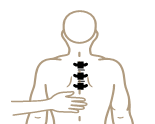T. D. M. Roberts has defined the essential characteristic of a reflex response (1967, p.9) as:
…a characterizable pattern of involuntary response which can be elicited with some regularity from an organism on presentation of the appropriate specific stimulus, provided that the connections to the central nervous system are intact.
Scientific studies tell us that a number and a variety of reflexes support the body and they are all are concerned with gravity. These reflexes are usually active simultaneously and we unconsciously co-ordinate their reactions. Professor Rudolph Magnus (1873 – 1927) classified one of these postural reactions as the ‘antigravity mechanism’, which enables the skeleton to support the body against gravity. All standard textbooks describe the effect produced by this mechanism. When one limb supports the body, the muscles of that limb automatically contract so that the joints brace in the extended position and the limb becomes, as Magnus describes it, a pillar. However, Magnus was referring to quadrupeds whose limbs are partially bent and so need a muscular activity to maintain this partial flexion. The exception seems to be the elephant whose limbs serve as static columns to maintain its enormous weight. The elephants’ weight-bearing limbs are so specialized that the elephant cannot jump, even for small distances. When comparing the muscles of the limb of an elephant to those of a human, the muscles of elephants are quite puny. Unlike the elephant with internal organs suspended from a horizontal spine, humans are constantly challenging gravity and we need antigravity muscles for powerful changes in posture from lying to sitting and standing.
When Basmajian (1978, p.178) tested this in humans using EMG (electromyogram – a recording of the electrical activity in skeletal muscle) he was able to show that, in standing, only a few of the leg muscles are active. The phenomenon is called ‘positive supporting reaction’ and is described in more detail by T. D. M. Roberts (1967, p.123). Basmajian shows that, for humans, supporting our vertical body over straight legs needs very little muscular activity with our ligaments passively stabilizing the joints. If we need more stability, the reflexes can then add muscular force to that stabilization. When in quiet standing on both feet, nearly all our muscles stay relaxed. When we start to walk, one leg has to bear nearly all our loads. The ligaments and reflex muscles then work as a net force to make the joints of the foot and leg more stable. This allows a greater force to travel upwards through the bones of the leg and foot without them buckling.
Muscles intended for movement are usually nearer the surface of the body and their action is to move the skeleton at the joints. If there is an interruption to the supporting reflexes, we have to contract movement muscles in order to support ourselves. However, muscles intended for movement fatigue if continuously contracted and we become aware of their tension. When we no longer trigger movement muscles inappropriately, there is less sense of effort and heaviness in the body. When we become conscious of this reality, it enables the supporting reflexes to be more effective and therefore to give the body better support.
All evidence suggests that poise is not the natural outgrowth of a process that begins in distraction, preoccupation and insensitivity.’
David Appelbaum
The Stop
